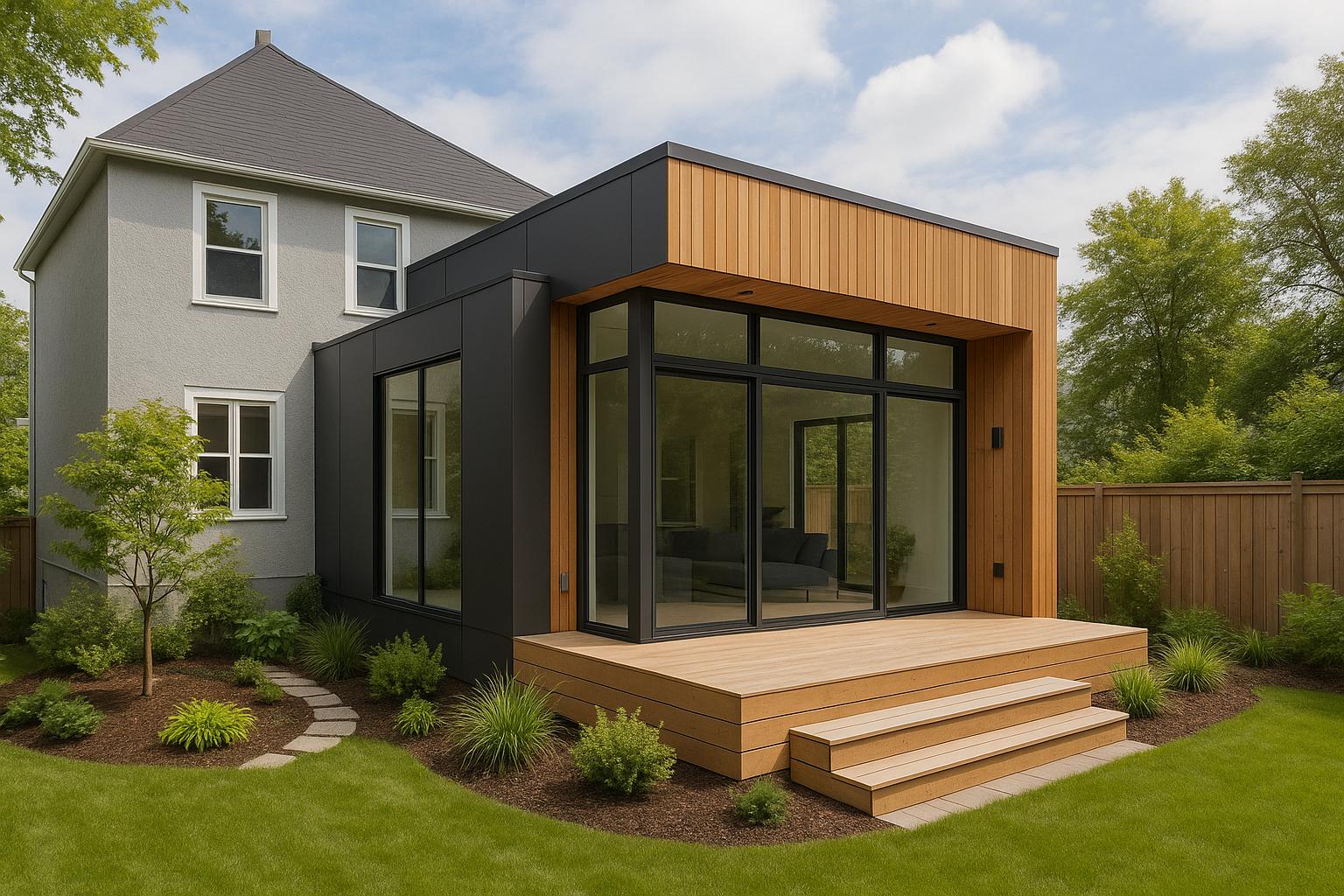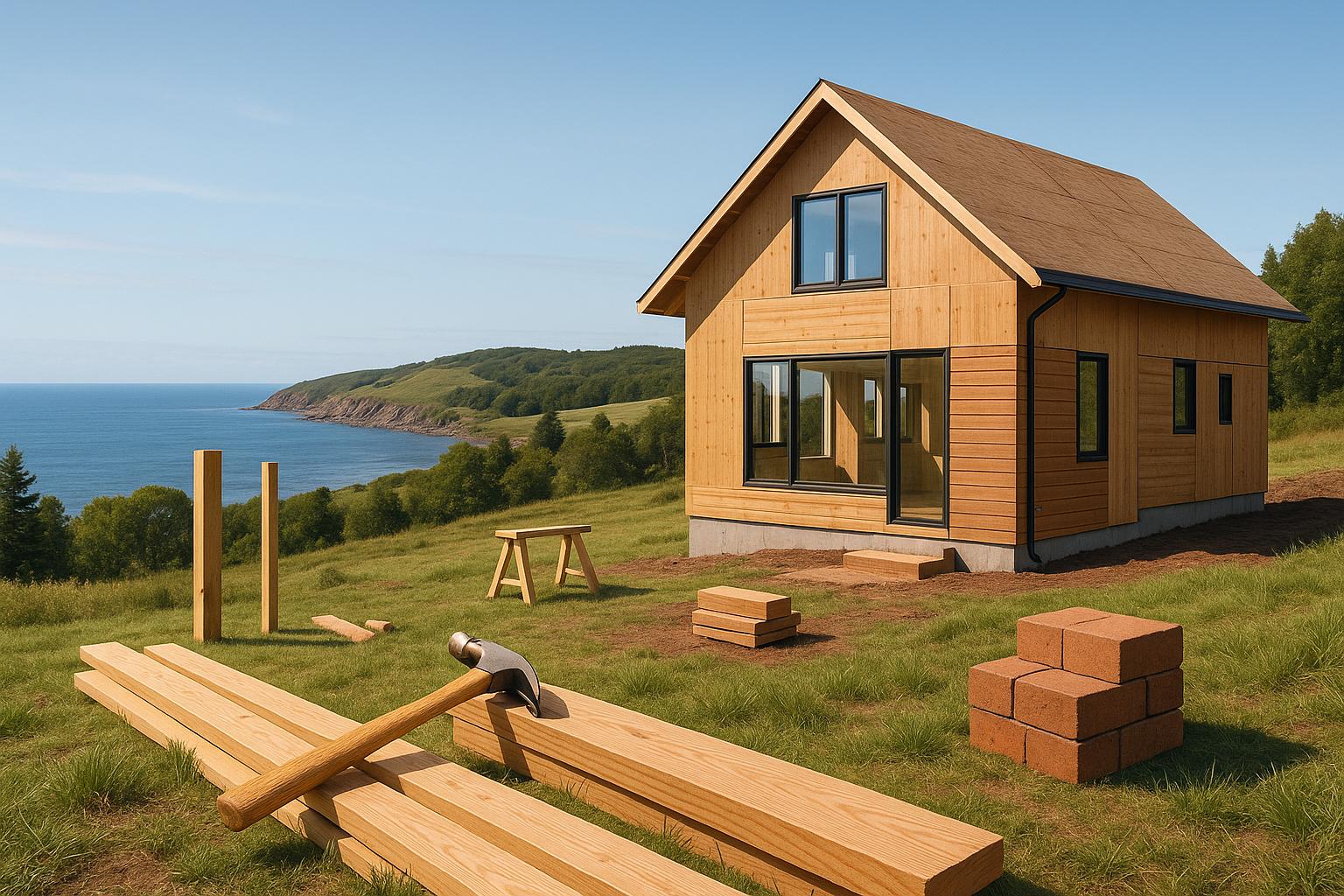Developers in Halifax face a key decision: build on two smaller adjacent lots or a single larger lot. Each option has unique pros and cons for construction costs, timelines, rental income, and resale flexibility. Here’s what you need to know:
-
Two Smaller Lots:
- Allows phased construction, reducing upfront costs.
- Generates rental income earlier.
- Offers flexibility for resale and rental strategies.
- Total cost for 8 units (two fourplexes) is about $1.28M.
- Gross monthly rental income: ~$16,800.
-
One Larger Lot:
- Requires full financing upfront and simultaneous construction.
- Simplified management but less flexibility.
- Higher risks if market conditions change.
Quick Comparison
| Factor | Two Smaller Lots | One Larger Lot |
|---|---|---|
| Construction Costs | $1.28M for 8 units (phased) | Higher upfront costs, all at once |
| Rental Income | ~ $16,800/month (diverse strategies) | Centralized, less diversification |
| Resale Flexibility | Sell one lot while keeping the other | Must sell entire property |
| Timeline | Phased, faster rental income generation | Longer due to simultaneous build |
For developers with limited capital, two smaller lots offer more flexibility and reduced risk. Those with greater resources may prefer the simplicity of a single-lot build. Both strategies hinge on Halifax’s zoning rules, which favour density and efficient layouts.
How neighbourhood zoning changes will help housing demand
Zoning and Density Rules
Halifax's zoning regulations evaluate each lot independently for factors like density and setbacks. This approach allows for creative and efficient layouts, especially when multiple lots are combined. If a property is divided into two adjacent lots, managing setbacks, parking, and building envelope restrictions for each lot often results in a more optimized design.
Projects on individual lots that align with by-right zoning standards now enjoy a simplified approval process. Recent changes have removed the need for variances or density bonuses, making it quicker and easier to move forward with development.
These zoning features can lead to potential savings in both time and costs, paving the way to explore construction expenses and rental revenue opportunities.
Costs, Timelines, and Rental Income
Let’s take a closer look at how construction costs, project timelines, and rental income can vary between different development approaches.
Zoning rules play a big role in determining unit density and overall costs. For example, while the per-unit construction cost is fixed at $160,000, factors like lot configuration and local zoning regulations can influence the total number of units you can build. Combining two adjacent lots, for instance, might allow for higher density, which in turn increases potential rental revenue.
Speaking of revenue, 2-bedroom rental units in Halifax typically bring in between $1,950 and $2,100 per month. Even a small uptick in the number of units can significantly boost annual returns, which often range from 12% to 20%. This highlights how crucial it is to maximize density when aiming for strong financial outcomes.
Timelines are another critical factor. Development strategies that allow for overlapping stages of work can cut down project durations. This means property owners can start renting out units sooner, improving cash flow once the project wraps up.
In Halifax's competitive rental market, efficiency and density aren’t just nice to have - they’re essential. Next, we’ll dive into specific development options and explore how they might impact resale value.
Development Options and Resale Value
When deciding between two adjacent lots or a single larger lot, property owners face choices that significantly impact long-term flexibility and potential resale opportunities. These decisions build on earlier considerations about construction costs and efficiency.
Advantages of Phased Construction
Opting for two adjacent lots opens the door to phased development, a strategy that's not as viable with single-lot projects. For instance, an owner could construct a fourplex on one lot and use the rental income to fund development on the second lot. This staggered approach not only lowers initial costs but also allows the owner to test market conditions. If rental demand proves stronger than anticipated, the next phase can be expedited. Conversely, if the market shifts unfavourably, construction can be paused, avoiding the risks of committing to a single, large-scale project all at once.
Flexible Exit Strategies
Two-lot developments also offer enhanced resale flexibility. Owners can sell one building while keeping the other, ensuring a steady stream of rental income even after a partial sale. This option is particularly useful when personal circumstances change or when market conditions make selling part of the investment more appealing. In contrast, selling a single large property often requires finding a buyer capable of handling a more substantial asset, which can limit the market.
This flexibility also allows owners to time sales strategically. For example, one property could be sold during a market upswing, while the other is held onto during less favourable conditions. This adaptability supports long-term planning, making it easier to align real estate investments with personal or financial goals. A single-lot development, on the other hand, often forces an all-or-nothing sale, which can be restrictive, especially if the property represents a significant portion of the owner’s net worth.
Adapting to Market Changes
Two-lot developments are better suited to adjusting to changing neighbourhood trends. If one side of the street appreciates faster or experiences higher rental demand, owners can adapt their strategies for each property. For instance, one building could be renovated to target a higher-end market, while the other remains affordable housing. While single-lot developments may benefit from economies of scale, they lack this level of strategic flexibility, limiting the ability to respond to shifting market dynamics effectively.
sbb-itb-16b8a48
1. Two Smaller Adjacent Lots
Owning two adjacent lots can open up more options for construction, financing, and management, all while increasing the potential return on investment (ROI).
Zoning and Density
This setup takes full advantage of zoning regulations to maximize the number of allowable units. In Halifax, current zoning rules often permit a fourplex on each lot. With two lots, that means the potential for eight rental units across two separate buildings. The setback rules for each lot also allow the buildings to be positioned closer to the street, all while staying within municipal guidelines.
Construction Costs and Timelines
Using a fixed-price approach of about $160,000 per unit, the total cost for eight units comes to roughly $1.28 million. A phased construction plan can ease financial strain - completing one fourplex first allows it to start generating rental income while work on the second building continues.
This staggered approach also streamlines timelines. With fewer trades on-site at once and simpler inspections, the process becomes more predictable and efficient, ultimately boosting rental profitability.
Rental Income Potential
Separate buildings offer an opportunity to diversify rental strategies. For instance, one could cater to young professionals, while the other focuses on families. Together, these two properties could bring in nearly $16,800 in gross monthly rental income, or over $200,000 annually. This setup also spreads out the risk of vacancies, helping to maintain steady cash flow even during slower rental periods.
Resale and Flexibility
Owning two lots provides unique long-term advantages. For example, you could sell one building while keeping the other, an option not available with a single, larger development. Smaller fourplexes are also more appealing to a wider range of potential buyers, especially those who might find it easier to secure financing for a smaller property. This dual-lot strategy not only diversifies exit options but also allows for experimenting with different management styles or market approaches, reducing risks compared to a single consolidated property.
2. One Larger Lot
At first glance, developing a single, larger lot in Halifax might seem like a straightforward choice. However, zoning rules, construction logistics, rental management, and resale challenges often limit its practicality. Let’s break down how these factors impact large-lot developments.
Zoning and Density
While a larger lot might appear to offer more space for additional units, Halifax’s zoning rules and setback requirements often curb that potential. These restrictions limit not just the number of units but also the flexibility in their layout. Smaller lots, on the other hand, allow for staggered construction phases, which can better adapt to zoning changes over time. In contrast, a large-lot development is locked into a single zoning designation, leaving little room for adjustments if regulations evolve.
Construction Costs and Timelines
Building on a single large lot means all construction happens at once. This approach requires full financing upfront and involves juggling multiple trades simultaneously, which can create logistical headaches. With so many crews working in a confined area, delays due to site congestion are almost inevitable. Compared to phased construction on smaller lots, this method often leads to longer timelines and higher costs.
Rental Income Potential
Managing rental units on a single large property comes with its own set of risks. Consolidating all units in one location limits the ability to diversify rental strategies, which can hurt overall profitability. Issues like noise complaints or parking disputes are more likely to arise, potentially driving tenants away. These challenges make it harder to maintain stable rental income over time.
Resale and Flexibility
Large-lot developments also face hurdles when it comes to resale. Unlike smaller, separate lots that can be sold individually, a single multi-unit property must be sold as one entity. This limits flexibility and often requires buyers to meet stricter financing conditions. Conventional residential lending options may not apply, making it harder for potential buyers to secure funding. For developers in Halifax, this lack of flexibility can pose a significant challenge when planning for long-term investment returns.
When comparing strategies, it’s clear that developing a single large lot comes with unique obstacles that often make it less appealing than the dual-lot approach.
Pros and Cons
When deciding between two smaller adjacent lots or one larger lot, certain factors like construction costs, rental income, and management flexibility need careful consideration.
| Factor | Two Smaller Adjacent Lots | One Larger Lot |
|---|---|---|
| Construction Flexibility | Allows phased construction, offering staggered financing and timeline adjustments. | Requires all construction to happen at once. |
| Financing Requirements | Lower upfront capital needed, enabling a phased approach. | Full financing must be secured before starting. |
| Resale Options | Each property can be sold individually, offering more flexibility. | Typically sold as a single entity, limiting buyer options. |
| Construction Timeline | Individual phases can reduce site congestion and shorten timelines. | Coordinated builds may extend the overall timeline. |
| Management Efficiency | Managing two projects increases administrative complexity. | Centralized management simplifies operations. |
The table highlights the core differences, but let’s dive into how these factors shape your project strategy.
Two Smaller Adjacent Lots
This option provides the ability to adapt to market conditions through phased construction, which also reduces upfront costs. However, the trade-off is increased administrative effort and coordination challenges when managing two separate developments.
One Larger Lot
Choosing a single larger lot simplifies property management and may lower per-unit construction costs due to economies of scale. On the other hand, it demands a higher initial financial commitment and exposes all units to market risks simultaneously.
For both approaches, the fixed-price model (CAD $160,000 per unit) and the integrated builder strategy help stabilize financial planning. The six-month construction guarantee is particularly useful for the two-lot strategy, ensuring timely completion of each phase so rental income (CAD $1,950–2,100 per month) can start flowing sooner.
Which Option Fits Your Goals?
If you’re working with limited upfront capital, the two-lot strategy offers flexibility and phased development. For those with substantial funds and a preference for streamlined management, a single-lot development might be the better path. Construction logistics are another key consideration. The integrated design-build approach minimizes coordination issues, but larger projects naturally bring more complexity. Smaller, phased developments reduce risks tied to delays and management challenges common in large-scale builds.
Ultimately, the decision comes down to aligning your financial capacity and management preferences with your broader development goals.
Conclusion
Shape your investment strategy around your financial situation and comfort with risk. If funds are tight, a phased two-lot approach could work well. On the other hand, if you have sufficient capital, a single-lot development might be a more straightforward choice.
Clarify your investment goals by deciding between prioritizing immediate rental income or focusing on long-term property value growth. Short-term strategies (around 5 years) tend to focus on rental returns, while longer-term plans (10+ years) aim to benefit from property appreciation [1].
Keep Halifax's dynamic real estate market in mind as you decide. As of January 2025, the average home price in Halifax is over CAD $600,000, with mortgage rates ranging from 4.8% to above 7% [3]. The city’s rapid population growth, fuelled by immigration and expanding job opportunities, has made it one of Canada’s fastest-growing markets. Both development strategies can yield competitive monthly rents of about CAD $1,950–2,100 for well-designed 2-bedroom units.
Create a detailed investment plan that outlines your criteria for buying and building in Halifax. Be prepared for potential interest rate hikes and consider starting small before scaling up [2]. The integrated design-build model, offering a fixed cost of CAD $160,000 per unit and a six-month construction guarantee, presents an opportunity for annual returns in the range of 12–20%.
FAQs
Why is building on two smaller lots often better than one larger lot in Halifax?
Halifax's ER-3 zoning rules offer a unique advantage for those considering smaller lots for multi-unit rental properties. For lots measuring 325 square metres or less, the regulations permit up to 60% lot coverage, compared to just 50% for larger lots. This means smaller parcels allow for more intensive development, making it possible to better utilise the land and boost rental income potential.
Interestingly, opting for two smaller adjacent lots instead of one larger lot can further enhance these benefits. This strategy not only increases flexibility in design and density but also helps streamline construction, potentially reducing obstacles. For property owners navigating Halifax's competitive rental market, this approach could lead to improved returns on investment.
Why is building on two smaller lots often a better option than developing a single larger lot?
Building on two smaller lots instead of one large one can offer some clear benefits, especially when it comes to managing costs and risks. By taking a phased approach to construction, property owners can spread their investment over time. This not only reduces financial strain but also provides the flexibility to adjust plans based on market trends or unexpected challenges. Starting with one project lets you gauge market demand before diving into the second, which can help improve your overall return on investment.
Smaller lots also tend to come with fewer zoning and permitting hurdles compared to larger developments. This can make the approval process smoother and cut down on delays. Plus, managing construction on a smaller scale is often more straightforward, helping you keep costs and timelines under control. In Halifax’s competitive property market, this approach offers a practical way to reduce risks while making the most of your development potential.
What are the pros and cons of building and managing rental properties on two smaller lots instead of one larger lot in Halifax?
Building and managing rental properties on two smaller lots comes with its own set of perks. For one, it offers more design and development options, allowing you to create properties that fit different needs. It also opens the door to higher density, which can be a smart move in Halifax's competitive rental market. Plus, spreading your investment across two lots can help reduce risks while increasing potential rental income.
That said, there are some hurdles to keep in mind. Managing two separate lots can mean higher upkeep costs, more involved tenant management, and extra administrative work. To make it work, you'll need a solid plan and a well-coordinated construction strategy. With the right approach, you can navigate Halifax's zoning rules and rental market while getting the best return on your investment.



